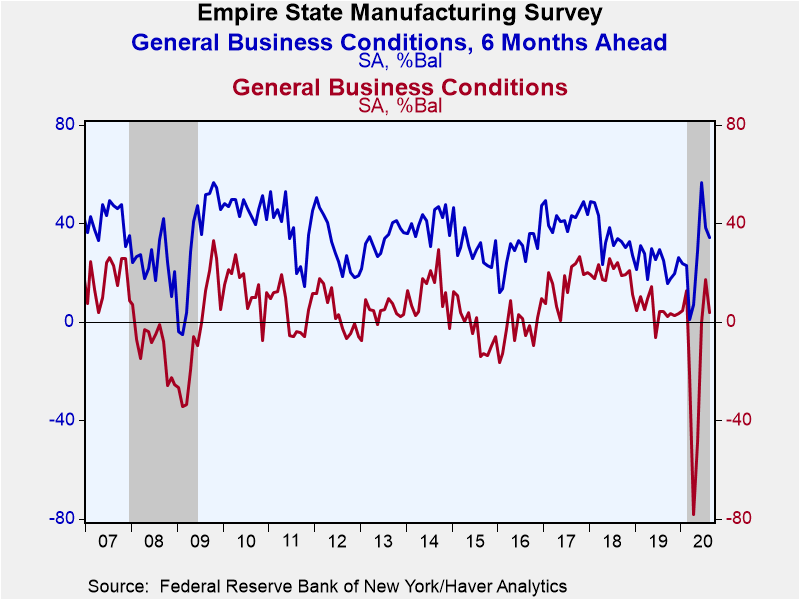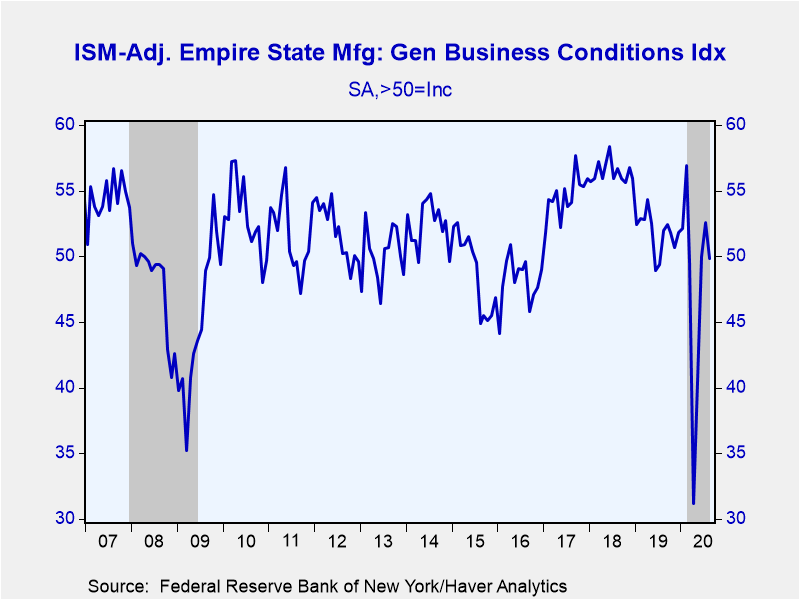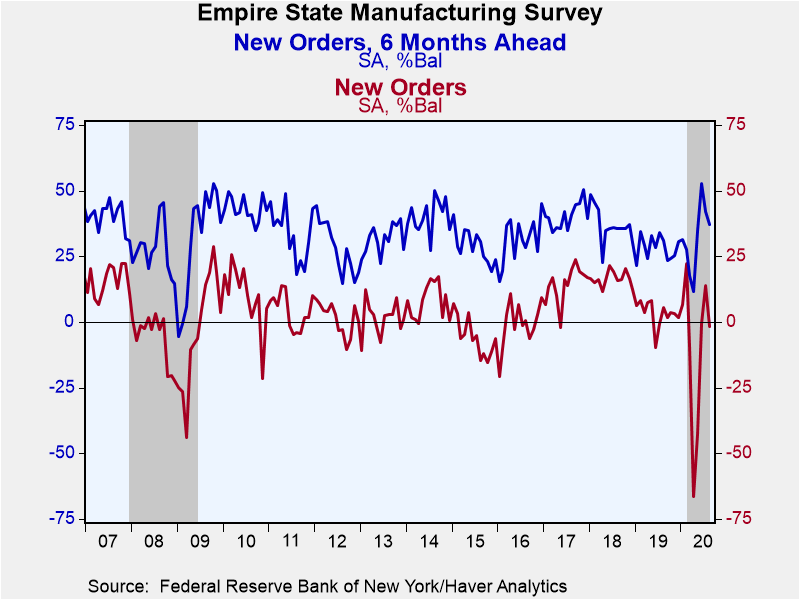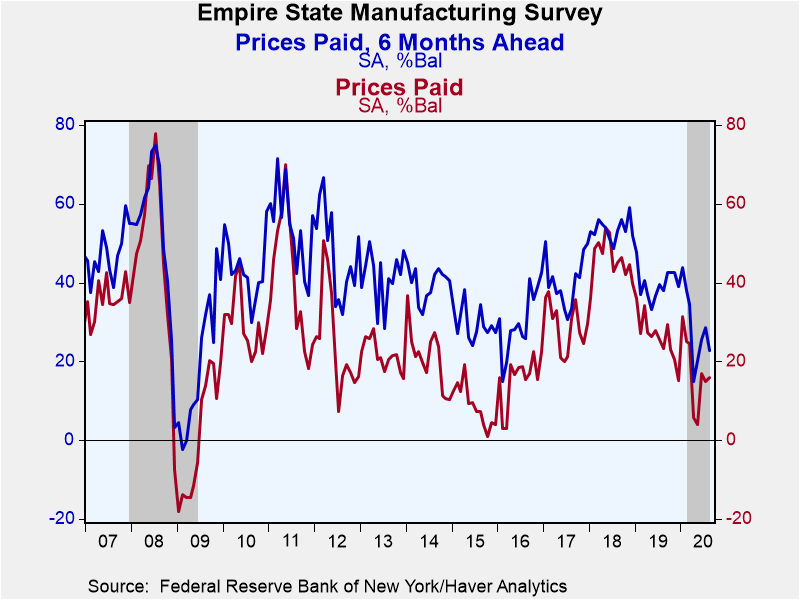 Global| Aug 17 2020
Global| Aug 17 2020Empire State Manufacturing Activity Improves Slowly in August
by:Tom Moeller
|in:Economy in Brief
Summary
Economic activity in New York continued to expand in August, but at a rate reduced from July's. The Empire State Manufacturing Index of General Business Conditions declined in August to 3.7 from 17.2. The figures remained up, however, [...]
Economic activity in New York continued to expand in August, but at a rate reduced from July's. The Empire State Manufacturing Index of General Business Conditions declined in August to 3.7 from 17.2. The figures remained up, however, versus negative readings logged from March through June. The August reading compared to 15.0 expected in the Action Economics Forecast Survey. A reduced 34% of respondents reported an increase in business conditions while an increased 30% reported a decline. The overall measure is a diffusion index which is constructed by subtracting the percentage decrease from the percentage increase and measures the breadth of change across the state.
Haver Analytics calculates an ISM-Adjusted Index which mimics the construction of the overall purchasing managers' index. The figure weakened this month to 49.8 from 52.6 in July. It was the first figure below the break-even point of 50 since May, but remained up from the recession low of 31.2 in April. The value of 50 for this index separates expansion from contraction.
Most of the underlying indexes in the report deteriorated this month. The new orders index declined to -1.7 in August and reversed its July improvement into positive territory. A lessened 33% of respondents reported higher orders while an increased 35% reported a decline. The shipments measure retraced most of its July improvement, while the unfilled orders and inventory measures returned to negative territory. The delivery times reading slipped and indicated slightly quicker product delivery speeds.
The employment indicators were mixed. The number of employees index rose to 2.4 this month, its best reading since February. The percentage reporting an increase in employment eased to 19% while the percentage reporting a decline fell to 17%. Working the other way, the average workweek measure fell to -6.8, its seventh consecutive negative reading.
The prices paid index improved slightly to 16.0 in August and reversed all but a fraction of its decline to 14.9 in July. The prices received index posted a positive 4.7, the first figure above zero since March. An increased nine percent of respondents reported higher prices while a reduced four percent indicated a decline.
Respondents in August were less optimistic about the next six months than they had been in July and June. The Expected General Business Conditions index in the Empire State Survey slipped to 34.3 from 38.4 in July, down from an eleven-year high of 56.5 in June. Expectations for orders and shipments deteriorated sharply, as did the employment and hours-worked readings. The capital expenditures figure eased slightly but was positive for the third straight month.
The Empire State figures are diffusion indexes, which are calculated by subtracting the percentage of respondents reporting declines from the percentage reporting gains. Their values range from -100 to +100. The data are available in Haver's SURVEYS database. The ISM-adjusted headline index dates back to 2001. The Action Economics Forecasts can be found in Haver's AS1REPNA database.
| Empire State Manufacturing Survey | Aug | Jul | Jun | Aug'19 | 2019 | 2018 | 2017 |
|---|---|---|---|---|---|---|---|
| General Business Conditions (Diffusion Index, %, SA) | 3.7 | 17.2 | -0.2 | 4.2 | 4.8 | 19.7 | 16.1 |
| General Business Conditions Index (ISM Adjusted, >50=Increasing Activity, SA) | 49.8 | 52.6 | 50.0 | 52.0 | 51.8 | 56.4 | 54.6 |
| New Orders | -1.7 | 13.9 | -0.6 | 5.6 | 3.3 | 16.4 | 14.4 |
| Shipments | 6.7 | 18.5 | 3.3 | 9.1 | 10.5 | 20.3 | 15.8 |
| Unfilled Orders | -14.0 | -0.6 | -12.5 | -9.7 | -6.0 | 3.5 | 1.9 |
| Delivery Time | 1.3 | 2.6 | 1.3 | 0.0 | -0.1 | 9.1 | 6.1 |
| Inventories | -10.7 | -9.7 | -0.6 | 5.8 | -0.9 | 5.9 | 1.5 |
| Number of Employees | 2.4 | 0.4 | -3.5 | -0.8 | 5.4 | 12.3 | 8.0 |
| Average Employee Workweek | -6.8 | -2.6 | -12.0 | -2.1 | 2.3 | 7.8 | 4.6 |
| Prices Paid | 16.0 | 14.9 | 16.9 | 23.2 | 26.3 | 45.8 | 29.0 |
| Prices Received | 4.7 | -4.5 | -0.6 | 4.5 | 10.3 | 19.3 | 11.0 |
| Expectations 6 Months Ahead | 34.3 | 38.4 | 56.5 | 25.1 | 23.9 | 35.2 | 42.6 |
Tom Moeller
AuthorMore in Author Profile »Prior to joining Haver Analytics in 2000, Mr. Moeller worked as the Economist at Chancellor Capital Management from 1985 to 1999. There, he developed comprehensive economic forecasts and interpreted economic data for equity and fixed income portfolio managers. Also at Chancellor, Mr. Moeller worked as an equity analyst and was responsible for researching and rating companies in the economically sensitive automobile and housing industries for investment in Chancellor’s equity portfolio. Prior to joining Chancellor, Mr. Moeller was an Economist at Citibank from 1979 to 1984. He also analyzed pricing behavior in the metals industry for the Council on Wage and Price Stability in Washington, D.C. In 1999, Mr. Moeller received the award for most accurate forecast from the Forecasters' Club of New York. From 1990 to 1992 he was President of the New York Association for Business Economists. Mr. Moeller earned an M.B.A. in Finance from Fordham University, where he graduated in 1987. He holds a Bachelor of Arts in Economics from George Washington University.










